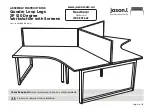
5
Using TRIGGER Controls
5-26
TDS1000B and TDS2000B Series Oscilloscopes – Operator Training Kit
To view the step response signal without overshoot and
ringing, follow these steps:
1. Pull the probe tip out of the probe tip lead.
2. Insert exposed probe tip into the probe socket on the
Training 1 signal board.
3. On the front panel, push the
SINGLE SEQ
button. The
word
Ready
will appear at the top of the display.
4. On the Training 1 signal board, push the
PRESS FOR
SINGLE SHOT
button to generate a high-speed single-
shot signal.
The words
Acq Complete
will appear at the top of the
display.
Summary of Contents for TDS1000B Series
Page 2: ......
Page 8: ...Environmental Considerations TDS1000B and TDS2000B Series Oscilloscopes Operator Training Kit ...
Page 14: ...vi TDS1000B and TDS2000B Series Oscilloscopes Operator Training Kit ...
Page 316: ...Appendix B Glossary B 10 TDS1000B and TDS2000B Series Oscilloscopes Operator Training Kit ...
















































